大众汽车标准_TL 533 硬聚乙烯 材料要求
- 格式:pdf
- 大小:114.00 KB
- 文档页数:3
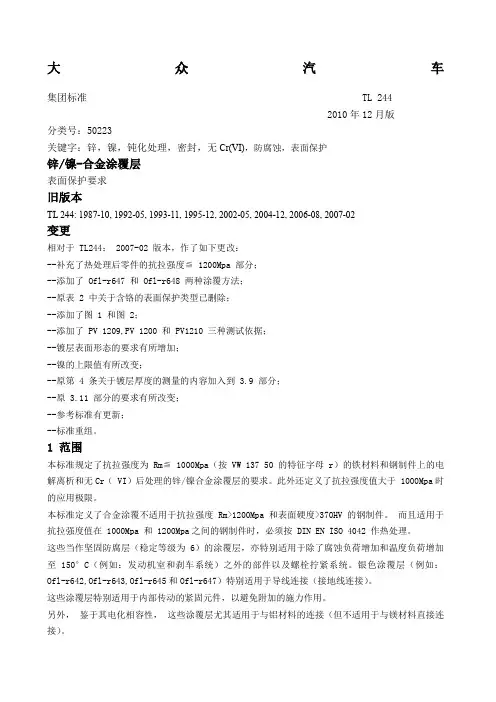
大众汽车集团标准 TL 2442010年12月版分类号:50223关键字:锌,镍,钝化处理,密封,无Cr(VI),防腐蚀,表面保护锌/镍-合金涂覆层表面保护要求旧版本TL 244: 1987-10, 1992-05, 1993-11, 1995-12, 2002-05, 2004-12, 2006-08, 2007-02变更相对于 TL244: 2007-02 版本,作了如下更改:--补充了热处理后零件的抗拉强度≦ 1200Mpa 部分;--添加了 Ofl-r647 和 Ofl-r648 两种涂覆方法;--原表 2 中关于含铬的表面保护类型已删除;--添加了图 1 和图 2;--添加了 PV 1209,PV 1200 和 PV1210 三种测试依据;--镀层表面形态的要求有所增加;--镍的上限值有所改变;--原第 4 条关于镀层厚度的测量的内容加入到 3.9 部分;--原 3.11 部分的要求有所改变;--参考标准有更新;--标准重组。
1 范围本标准规定了抗拉强度为 Rm≦ 1000Mpa(按 VW 137 50 的特征字母 r)的铁材料和钢制件上的电解离析和无Cr( VI)后处理的锌/镍合金涂覆层的要求。
此外还定义了抗拉强度值大于 1000Mpa时的应用极限。
本标准定义了合金涂覆不适用于抗拉强度 Rm>1200Mpa 和表面硬度>370HV 的钢制件。
而且适用于抗拉强度值在 1000Mpa 和 1200Mpa之间的钢制件时,必须按 DIN EN ISO 4042 作热处理。
这些当作坚固防腐层(稳定等级为 6)的涂覆层,亦特别适用于除了腐蚀负荷增加和温度负荷增加至150°C(例如:发动机室和刹车系统)之外的部件以及螺栓拧紧系统。
银色涂覆层(例如:Ofl-r642,Ofl-r643,Ofl-r645和Ofl-r647)特别适用于导线连接(接地线连接)。
这些涂覆层特别适用于内部传动的紧固元件,以避免附加的施力作用。
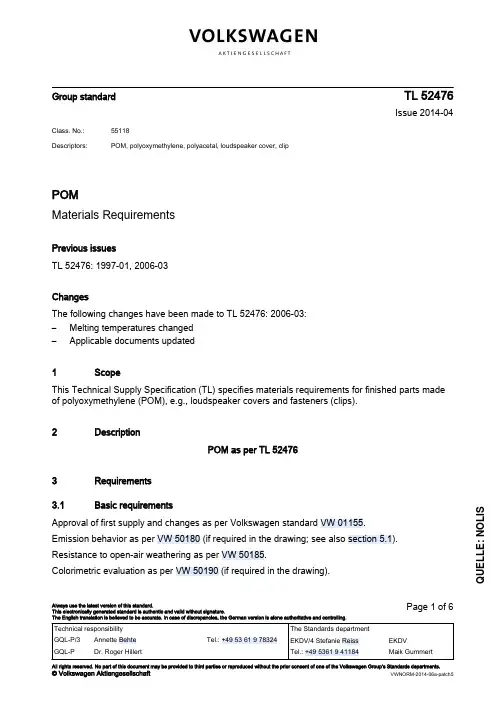
Group standardTL 52476Issue 2014-04Class. No.:55118Descriptors:POM, polyoxymethylene, polyacetal, loudspeaker cover, clipPOMMaterials RequirementsPrevious issuesTL 52476: 1997-01, 2006-03ChangesThe following changes have been made to TL 52476: 2006-03:–Melting temperatures changed –Applicable documents updated ScopeThis Technical Supply Specification (TL) specifies materials requirements for finished parts made of polyoxymethylene (POM), e.g., loudspeaker covers and fasteners (clips).DescriptionPOM as per TL 52476RequirementsBasic requirementsApproval of first supply and changes as per Volkswagen standard VW 01155.Emission behavior as per VW 50180 (if required in the drawing; see also section 5.1).Resistance to open-air weathering as per VW 50185.Colorimetric evaluation as per VW 50190 (if required in the drawing).123 3.1Always use the latest version of this standard.This electronically generated standard is authentic and valid without signature.The English translation is believed to be accurate. In case of discrepancies, the German version is alone authoritative and controlling.Page 1 of 6All rights reserved. No part of this document may be provided to third parties or reproduced without the prior consent of one of the Volkswagen Group’s Standards departments.© Volkswagen AktiengesellschaftVWNORM-2014-06a-patch5Q U E L L E : N O L I SPage 2TL 52476: 2014-04Avoidance of hazardous substances as per VW 91101.10 finished parts are required for complete testing; for fasteners (like clips), 20 finished parts are required.PropertiesThe surface and interior of the finished parts must be free of flaws and processing defects such as flow lines, cracks, air traps, or similar defects. Sink marks at the base of ribs and reinforcements are only permissible if they do not adversely affect the function, appearance, and/or assembly of the parts. The finished parts must allow for trouble-free installation.PackagingFinished parts must be packed in a way that allows air circulation. For delivery in large packaging units (cardboard boxes, pallets), the finished parts must be stacked or arranged so that air circula‐tion is possible.Marking as per VDA 260> POM <ConditioningPrior to testing, the specimens must be conditioned in the ISO 554-23/50 standard climate for at least 24 h.Evaluation of the measurement resultsThe required numerical values apply to each individual measurement.MaterialSee section 5.2.Polyoxymethylene (POM) homopolymer or, alternatively, copolymer.ColorAs per drawing and/or release.PropertySee table 1.3.1.13.1.23.2 3.33.43.53.64Page 3TL 52476: 2014-04 Table 1Page 4TL 52476: 2014-04Notes on testing Emission behaviorIf the test results do not comply with the requirements of VW 50180, the parts must be tempered until the limit values are met. The temperature must be selected such that no changes in shape,color, and to the surface occur.MaterialThe identity test is performed with infrared spectroscopy.Melting temperatureIf the differential scanning calorimetry (DSC) method is used to determine the melting temperature,the following procedure must be used:Test equipment such as the DSC 821e from Mettler Toledo can be used. A plane-parallel finished part section with a weight of approx. (5 to 10) mg is used as the specimen.Test parameters: Heat the specimen from +50 °C to +200 °C at a heating rate of 10 °C/min. After‐wards, cool it down to +50 °C at a rate of 5 °C/min and then reheat it at a rate of 10 °C/min to +200 °C. Perform the test under normal atmospheric conditions.Yield stress and yield strainTensile test as per DIN EN ISO 527-2, specimen type 5A, test speed: 50 mm/min. If no 5A speci‐men is available, it is permissible to use S3A tensile specimens (dumb-bell specimen) as per DIN 53504.Impact strengthTest equipment: 4 J pendulum impact tester.If for reasons concerning equipment and/or specimen shape and size a test as per table 1, con‐sec. no. 6 cannot be performed, the following procedure can be used as a substitute:Impact resistance test (broadside impact) as per DIN EN ISO 179-1, but with: specimen length of (50 ± 1) mm, width of (6 ± 0.2) mm, thickness matching the thickness of the finished product (up to a max. of 4 mm); distance between supports: 40 mm; test equipment: 4 J pendulum impact tester.Specimens taken from finished parts grained or painted on one side are placed on the supports of the pendulum impact tester so that the grained or painted side faces the direction of impact.Note that this procedure requires prior agreement.Notched impact strengthTest equipment: 4 J pendulum impact tester.If for reasons concerning equipment and/or specimen shape and size a test as per table 1, con‐sec. no. 7 cannot be performed, the following procedure can be used as a substitute:Impact resistance test (broadside impact) as per DIN EN ISO 179-1, but with: specimen length of (50 ± 1) mm, width of (6 ± 0.2) mm, thickness matching the thickness of the finished product (up to a max. of 4 mm); distance between supports: 40 mm; test equipment: 4 J pendulum impact tester.5 5.15.25.35.45.55.6Page 5TL 52476: 2014-04A 0.8 mm-wide U-shaped notch is made on the broad side of the specimens. The notch depth is 1/3 of the specimen thickness. The edges outlining the notch root must have a curvature radius of < 0.1 mm.Finished parts with one-sided graining must be notched on the grained side and subsequentlyplaced on the pendulum impact tester’s specimen supports in such a manner that the center of the notch is precisely within the impact plane. Care must be taken that the notch is located on the side facing away from the hammer edge. Note that this procedure requires prior agreement.Elevated-temperature behaviorHeat aging test as per DIN 53497, method B, on at least one complete finished part; aging temper‐ature of (+90 ± 1) °C; aging duration of (22 + 2) h.Low-temperature behaviorA minimum of 2 complete finished parts are aged in air at (-30 ± 1) °C; aging period (22 + 2) h.Ball drop testBall drop test as per PV 3905, but with: base plate (specimen support surface) made of steel sheet with a thickness ≥10 mm; no depression on at least three finished parts. Ball drop height:(450 ± 5) mm.LightfastnessIf the number of periods of exposure is not defined in the drawing, the following rule applies:– 3 periods of exposure for components in areas with indirect solar radiation– 5 periods of exposure for components in areas with direct solar radiation (e.g., door waist rail).–10 periods of exposure for components in areas with the highest solar radiation (e.g., rearshelf).Applicable documentsThe following documents cited in this standard are necessary to its application.Some of the cited documents are translations from the German original. The translations of Ger‐man terms in such documents may differ from those used in this standard, resulting in terminologi‐cal inconsistency.Standards whose titles are given in German may be available only in German. Editions in other languages may be available from the institution issuing the standard.PV 1303Non-Metallic Materials; Exposure Test of Passenger Compartment Com‐ponentsPV 3905Organic Materials; Ball Drop TestTL 1010Materials for Vehicle Interiors; Burning Behavior; Material Requirements VW 01155Vehicle Parts; Approval of First Supply and ChangesVW 50180Components in the Passenger Compartment; Emission Behavior VW 50185Vehicle Parts; Resistance to Open-Air Weathering5.75.85.95.106Page 6TL 52476: 2014-04VW 50190Interior Trim Components; Metrological Evaluation of Color and GlossLevel; Visual Evaluation of Chrome SurfacesVW 91101Environmental Standard for Vehicles; Vehicle Parts, Materials, Operat‐ing Fluids; Avoidance of Hazardous SubstancesDIN 53497Testing of Plastics; Hot Storage Test on Mouldings Made of Thermo‐plastic Moulding Materials without External Mechanical StressingDIN 53504Testing of rubber - determination of tensile strength at break, tensilestress at yield, elongation at break and stress values in a tensile test DIN EN 20105-A02Textiles - Tests for colour fastness - Part A02: Grey scale for assessingchange in colourDIN EN ISO 1183-1Plastics - Methods for determining the density of non-cellular plastics -Part 1: Immersion method, liquid pyknometer method and titration meth‐odDIN EN ISO 179-1Plastics - Determination of Charpy impact properties - Part 1: Non-instru‐mented impact testDIN EN ISO 306Plastics - Thermoplastic materials - Determination of Vicat softeningtemperature (VST)DIN EN ISO 3146Plastics - Determination of melting behaviour (melting temperature ormelting range) of semi-crystalline polymers by capillary tube and polariz‐ing-microscope methodsDIN EN ISO 527-2Plastics - Determination of tensile properties - Part 2: Test conditions formoulding and extrusion plasticsISO 554Standard atmospheres for conditioning and/or testing; Specifications VDA 260Components of motor vehicles - Marking of material。
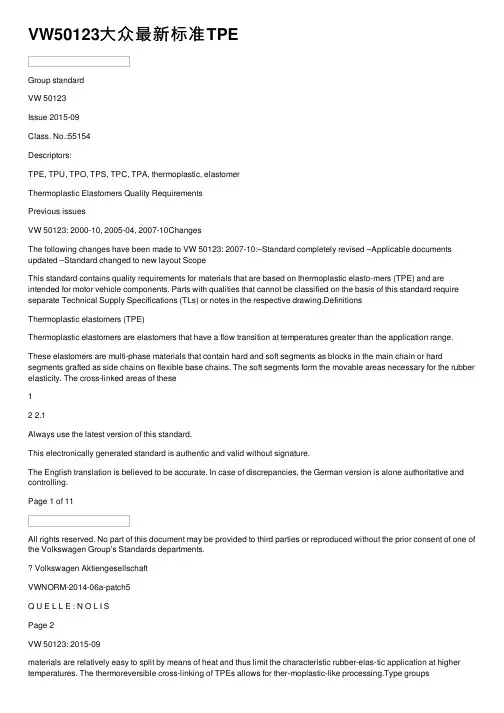
VW50123⼤众最新标准TPEGroup standardVW 50123Issue 2015-09Class. No.:55154Descriptors:TPE, TPU, TPO, TPS, TPC, TPA, thermoplastic, elastomerThermoplastic Elastomers Quality RequirementsPrevious issuesVW 50123: 2000-10, 2005-04, 2007-10ChangesThe following changes have been made to VW 50123: 2007-10:–Standard completely revised –Applicable documents updated –Standard changed to new layout ScopeThis standard contains quality requirements for materials that are based on thermoplastic elasto‐mers (TPE) and are intended for motor vehicle components. Parts with qualities that cannot be classified on the basis of this standard require separate Technical Supply Specifications (TLs) or notes in the respective drawing.DefinitionsThermoplastic elastomers (TPE)Thermoplastic elastomers are elastomers that have a flow transition at temperatures greater than the application range.These elastomers are multi-phase materials that contain hard and soft segments as blocks in the main chain or hard segments grafted as side chains on flexible base chains. The soft segments form the movable areas necessary for the rubber elasticity. The cross-linked areas of these12 2.1Always use the latest version of this standard.This electronically generated standard is authentic and valid without signature.The English translation is believed to be accurate. In case of discrepancies, the German version is alone authoritative and controlling.Page 1 of 11All rights reserved. No part of this document may be provided to third parties or reproduced without the prior consent of one of the Volkswagen Group’s Standards departments.Volkswagen AktiengesellschaftVWNORM-2014-06a-patch5Q U E L L E : N O L I SPage 2VW 50123: 2015-09materials are relatively easy to split by means of heat and thus limit the characteristic rubber-elas‐tic application at higher temperatures. The thermoreversible cross-linking of TPEs allows for ther‐moplastic-like processing.Type groupsTypes with low hardnessHardness range ≤ 65 Shore A and hardness range > 65 Shore A.Material designations (as per DIN EN ISO 18064); Designation examples:–Urethane thermoplastic elastomer (TPU)> TPU-ARES <(aromatic hard segments/ester soft segments)> TPU-ARET <(aromatic hard segments/ether soft segments)–Ethylene propylene diene rubber(EPDM)/polypropylene (PP) thermo‐plastic elastomer (olefinic thermoplas‐tic elastomer (TPO) or thermoplasticvulcanizate (TPV))> TPO-(EPDM+PP) TPV-(EPDM+PP) <In the case of cross-linked elastomer phases –Styrenic thermoplastic elastomer(TPS)> TPS-SBS <> TPS-SEBS <Types with high hardnessHardness range of 40 to 50 Shore D.Material designations:–Copolyester thermoplastic elastomer(TPC)> TPC-EE <–Polyamide thermoplastic elastomer(TPA)> TPA-ES <DesignationRefer to DIN EN ISO 18064 for the designations of thermoplastic elastomers.Designation example for a black-dyed, lightfast TPO with a preferred hardness of 60 Shore A and a density of 1.04 g/cm 3: TPO-(EPDM+PP) as per Volkswagen standard VW 50123 – 60 Shore A, black, 1.04 g/cm 3, light‐fast Requirements Basic requirementsApproval of first supply and changes as per Volkswagen standard VW 01155Avoidance of hazardous substances as per VW 91101.2.2 2.2.12.2.234 4.1Page 3VW 50123: 2015-09In terms of the raw materials on which they are based, the materials used in components that are made of thermoplastic elastomers and that are subject to dynamic loads during driving operation must be free of recycled material. Within this context, "recycled material" refers to products from a recycling process (thermal, mechanical, and/or chemical) used to recycle material from used com‐ponents.For components subject to dynamic loads, using regrind (from the material fed directly into the components' own manufacturing process) is permissible up to a limit of 20%, provided that the re‐quired material level for the component is consistently reached so that the use of regrind does not have a significant impact on the required material properties.TPE qualities are preferably tested on components, component sections or, in exceptional cases,test plates.Samples must always be delivered with the manufacturer’s quality designation.The number of parts required for laboratory tests must be agreed upon with the appropriate Materi‐als Laboratory in each case.When manufacturing plate material, anisotropic effects (= orientation of macromolecules during production) can be expected as a result of the molding material injection process (gate marks).This will lead to differences in the mechanical characteristic values of strength and elongation de‐pending on the direction of the orientations. This must be taken into account during testing. To this end, appropriate specimens must be taken from the plate material both in the longitudinal and transverse directions and torn apart. Generally, the specimens taken transversely to the direction of orientation of the macromolecules will have lower strength and elongation values.The specimens to be used for laboratory tests as per this standard must be taken transversely to the orientation of the macromolecules.Evaluation of the measurement resultsThe required numerical values apply to each individual measurement.Color in as-received conditionAs per drawing.AppearanceNo visible flaws, inclusions, etc.Material identificationInfrared spectroscopy, pyrolysis gas chromatography mass spectrometry (Py-GC-MS)couplingPy-GC-MS as per Test Specification PV 3935.ThermogravimetrySee section 6.1.Volatile, polymer, and nonvolatile percentages must be specified.4.24.34.44.5 4.5.14.5.2Page 4VW 50123: 2015-09Differential scanning calorimetry (DSC)See section 6.2.The following must be specified: Enthalpy of fusion, melting range (T m reflects the start of melting,not the peak maximum), 1st heat-up curve, 1st crystallization curve, 2nd heat-up curve, and 2nd crystallization curve.Dimensional stability under heat as per DIN EN ISO 306, method BOnly if required in the drawing; as per the released sample.Density as per DIN EN ISO 1183-1Specified as per drawing.Hardness Shore AHardness range of 55 Shore A to 80 Shore A for TPE that are primarily exposed to daylight and weather effects (e.g., TPO, TPV).Shore DHardness range of 40 Shore D to 50 Shore D for TPE that may also come into contact with operat‐ing fluids such as oils, greases, fuels, blowby gases (limited resistance) (e.g., TPC).Low-temperature elasticity after 22 h at -40 °C GeneralrequirementsNo cracks or fractures under manual bending stress.Freeze temperature T GAs per drawing.Ozone resistance as per VW 2.8.1, installed in a manner similar to that used during op‐erationFree of cracks.Flammability as per TL 1010As per drawing.Lightfastness as per VW 2.8.1No changes compared to the as-received condition, e.g., discoloration, embrittlement, decomposi‐tion, cracks. Only required if "lightfast" is additionally specified in the drawing.4.5.3 4.5.44.5.54.6 4.6.14.6.24.7 4.7.14.7.24.84.94.10Page 5VW 50123: 2015-09Emission behavior as per VW 50180.As per drawing.PropertiesFor the Shore A hardness range, see table 1. For the Shore D hardness range, see table 2.In justified cases, deviating limits may be specified in agreement with the appropriate Volkswagen Group Materials Engineering department.Table 1 – Shore A hardness range4.11 5Page 6VW 50123: 2015-09Table 2 – Shore D hardness rangePage 7 VW 50123: 2015-09Page 8VW 50123: 2015-09Notes on testing ThermogravimetryThermogravimetric analysis as per PV 3927.Components as percentages and/or pyrolysis gas chromatography mass spectrometry as an iden‐tification check.Differential scanning calorimetry (DSC)A device such as the PerkinElmer DSC7 analyzer can be used for testing.The specimen is a plane-parallel finished part section with an approx. mass of 10 mg. The speci‐men is heated up from 50°C to 310 °C at 10 °C/min. Afterward, the specimen is cooled down to 150 °C at 5 °C/min and then heated up again to 310°C at 10 °C/min. The test is performed under normal atmospheric conditions. In order to evaluate the enthalpy of fusion of the polymer, the resi‐due determined with the thermogravimetric analysis must be subtracted from the actual original specimen weight.Heat agingAging in a forced-air oven as per DIN 53508. The aging durations and temperatures must be agreed upon. Measurements are taken after cooling down to room temperature (23 ±2) °C.6 6.16.26.3Page 9VW 50123: 2015-09Aging in operating fluids GasolineThe specimens are aged in FAM test fluid as per DIN 51604-2 (FAM 2).Composition:–84.5 volume percent FAM test fluid as per DIN 51604-1 (FAM 1)–15.0 volume percent methanol –0.5 volume percent waterOther test fluids may be used if required (deviations as per drawing).168-h aging (other aging durations as per drawing specification) at a room temperature of(23 ±2) °C; the specimens must be blotted with filter paper (black band) after aging; they are evalu‐ated 1 minute after this (in justified cases, which require agreement, the evaluation may also begin 15 minutes after removal).Diesel fuel, fatty acid methyl ester (FAME)168-h aging at room temperature (23 ±2) °C. In justified cases, other aging durations and test tem‐peratures can be agreed upon.The following test composition must be used for aging in diesel fuel:–80 volume percent Liquid F standard diesel (formerly A20 NPII made by Haltermann) as perDIN ISO 1817–20 volume percent fatty acid methyl ester (FAME) as per DIN EN 14214. Soy methyl estermust be used as the fatty acid methyl ester component.In justified cases, the use of the following test mixture is also permissible for aging in diesel fuel:–93 volume percent Liquid F standard diesel (formerly A20 NPII made by Haltermann) as perDIN ISO 1817–7 volume percent fatty acid methyl ester (FAME) as per DIN EN 14214 with rapeseed oil meth‐yl ester as the fatty acid methyl ester component Aging at an elevated temperature is performed using a reflux condenser.After the aging time ends, the specimens must be cleaned with a lint-free cloth. Specimens that have been aged at an elevated temperature can be left in the test fluid to cool down to the ambient temperature. The evaluations are carried out 1 min after the specimens are removed from the me‐dium.Engine oil, transmission fluid, and grease96-h aging duration. In justified cases, other aging times and test temperatures can be agreed upon.CoolantS 3A dumb-bell specimens as per DIN 53504 are aged in test fluid consisting of 50 parts by vol‐ume of deionized water, and50 parts by volume of coolant additive as per TL 774 at 135 °C in an autoclave. The fluid volume must be 150 to 180 times the specimen volume. After this, the speci‐mens are cooled down to (23 ±2) °C in the test fluid within 2 h and measured. Aging duration: 94 h. In justified cases, other aging durations may also be agreed upon.6.4 6.4.16.4.26.4.36.4.4Page 10VW 50123: 2015-09Brake fluidThe test specimens are aged in 75 ml of brake fluid for 70 h at 120 °C. Glass containers with an approx. volume of 250 ml and a diameter of 50 mm must be used – and tightly sealed – for this purpose. After the test is over, the elastomer parts are acclimatized in the container at (23 ±2) °C for 60 min to 90 min. The specimens are then removed from the fluid; rinsed briefly (max. 10 s) in isopropanol; and dried with a clean, fiber-free cloth. The measurements must be performed within 60 min of the specimens being rinsed in alcohol.Applicable documentsThe following documents cited in this standard are necessary to its application.Some of the cited documents are translations from the German original. The translations of Ger‐man terms in such documents may differ from those used in this standard, resulting in terminologi‐cal inconsistency.Standards whose titles are given in German may be available only in German. Editions in other languages may be available from the institution issuing the standard.PV 3307Elastomer Components; Plastic and Elastic DeformabilityPV 3927Thermogravimetric Analysis for Plastics and Elastomers; Determination:Plasticizers, Carbon BlackPV 3935Plastics and Elastomers; Pyrolytic Gas Chromatography/Mass Spec‐trometryPV 3936Polymer Materials; Testing the Resistance to Components of Blowby GasesTL 1010Materials for Vehicle Interiors; Burning Behavior; Material Requirements TL 52185Reference Engine Oil SAE 5W-30 for Testing of Compatibility with Re‐spect to Elastomer Materials; Lubricant RequirementsTL 726Transmission Oil APl GL 4 SAE 75W / SAE 80W; Lubricant Require‐mentsTL 735Multi-Purpose Grease; Lubricant RequirementsTL 745Multi-Purpose Low-Temperature Grease; Lubricant Requirements TL 766Brake Fluid; Material RequirementsTL 774Ethylene Glycol-Based Coolant Additive; Materials Requirements VW 01155Vehicle Parts; Approval of First Supply and Changes VW 2.8.1Elastomers; Materials Requirements and Testing VW 50180Components in the Vehicle Interior; Emission BehaviorVW 91101Environmental Standard for Vehicles; Vehicle Parts, Materials, Operat‐ing Fluids; Avoidance of Hazardous SubstancesDIN 51604-1FAM testing fluid for polymer materials; Composition and requirements DIN 51604-2Methanolic FAM testing fluid for polymer materials; composition and re‐quirements6.4.5 7Page 11VW 50123: 2015-09 DIN 53504Testing of rubber - determination of tensile strength at break, tensilestress at yield, elongation at break and stress values in a tensile test DIN 53508Testing of rubber - Accelerated ageingDIN 53512Testing of rubber - Determination of rebound resilience (Schob pendu‐lum)DIN EN 14214Liquid petroleum products - Fatty acid methyl esters (FAME) for use in diesel engines and heating applications - Requirements and test meth‐odsDIN EN ISO 1183-1Plastics - Methods for determining the density of non-cellular plastics -Part 1: Immersion method, liquid pyknometer method and titration meth‐odDIN EN ISO 179-1Plastics - Determination of Charpy impact properties - Part 1: Non-instru‐mented impact testDIN EN ISO 18064Thermoplastic elastomers - Nomenclature and abbreviated termsDIN EN ISO 306Plastics - Thermoplastic materials - Determination of Vicat softening temperature (VST)DIN ISO 1817Rubber, vulcanized - Determination of the effect of liquidsDIN ISO 34-1Rubber, vulcanized or thermoplastic - Determination of tear strength -Part 1: Trouser, angle and crescent test piecesDIN ISO 7619-1Rubber, vulcanized or thermoplastic - Determination of indentation hard‐ness - Part 1: Durometer method (Shore hardness)。
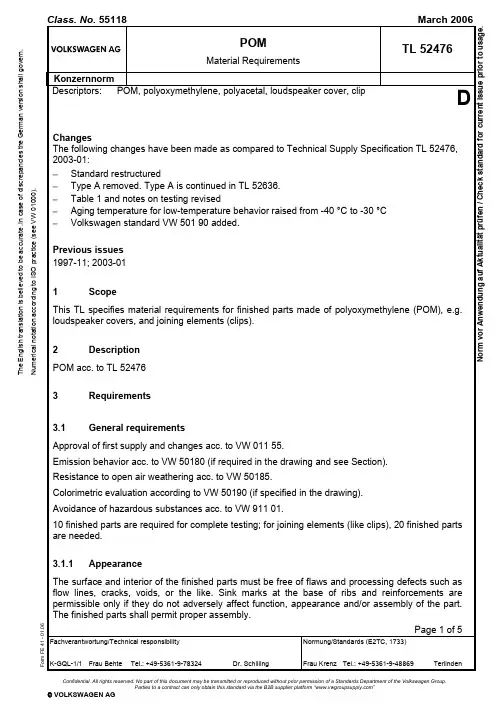
Confidential. All rights reserved. No part of this document may be transmitted or reproduced without prior permission of a Standards Department of the Volkswagen Group.Parties to a contract can only obtain this standard via the B2B supplier platform “”VOLKSWAGEN AGPage 2TL 524 76: 2006-03D3.1.2 PackagingFinished part packaging shall not be air tight to allow air circulation. In case of delivery in large packaging units (cardboard boxes, pallets), they should be stacked or arranged so that air circulation is possible.3.2 Marking according to VDA 260>POM<3.3 ConditioningPrior to testing, the specimens required for the individual tests must be conditioned for at least 48 h in the DIN 50014 – 23/50-2 standard climate.3.4 Evaluation of the measuring resultsThe required numerical values apply to each individual measurement.3.5 MaterialSee Section 5.2.Polyoxymethylene (POM) homopolymer, or copolymer alternatively.3.6 ColorAccording to drawing and/or release.4 PropertiesSee Table 1.Table 1No. Property Requirement1 Density acc. to DIN EN ISO 1183-1, buoyancy(1,42 ± 0,02) g/cm3method2 Melting temperature acc. to DIN EN ISO 3146,+166 °C to +179 °Calternatively with DSCsee Section 5.33 Dimensional stability under heat acc. to Vicat and≥ 145 °CDIN EN ISO 306, method B50≥ 60 MPa4 Yield stress acc. to DIN EN ISO 527-2see Section 5.45 Elongation acc. to DIN EN ISO 527-2≥ 6,5%see Section 5.46 Impact resistance acc. to DIN EN ISO 179-1/1eUNo fracture (kJ/m2)see Section 5.57 Notched impact strength acc. to DIN EN ISO 179-≥ 4,5 kJ/m21/1eA.see Section 5.6Page 3TL 524 76: 2006-035 Notes on testingbehavior5.1 EmissionIf the test results do not comply with the requirements of VW 50180, the parts shall be tempered until the limit values are met. The temperature shall be selected such that no changes in form, color, and surface occur.5.2 MaterialThe identity test is performed using infrared spectroscopy.temperature5.3 MeltingIf the DSC method is chosen to identify the melting temperature, the following procedure shall be applied:Test equipment such as the DSC 821e from Mettler Toledo can be used. A plane parallel finished part section of a weight of approx. 5 mg to 10 mg serves as specimen.Testing parameters: The specimen is heated from +50 °C to +200 °C at a heating rate of 10 °C/min. Afterwards, it is cooled with 5° C/min to +50° C and reheated with 10° C/min to +200° C. The test is carried out in normal atmosphere.Page 4TL 524 76: 2006-03D5.4 Yield stress and elongationTensile test according to DIN EN ISO 527-2, 5A specimen, test rate 50 mm/min. In case the 5A specimen cannot be prepared, it is permissible to use S3A tensile specimens (standard test specimens) acc. to DIN 53504.strength5.5 ImpactTest equipment: pendulum impact tester 4J.If for reasons concerning equipment and/or specimen shape and size a test according to Table 1 No. 6 cannot be performed, the following procedure may be substituted:Impact resistance test (broadside impact) according to DIN EN ISO 179-1; deviating specimen length: (50 ± 1) mm, width: (6 ± 0,2) mm, thickness according to product thickness (up to max.4 mm); mounting flange interval (support separation): 40 mm, test equipment: pendulum impact tester 4J.Specimens taken from finished parts grained or painted on one side are placed on the mounting flange of the pendulum impact tester so that the grained or painted side faces the direction of impact.Note that this procedure requires prior agreement.5.6 Notched impact strengthTest equipment: pendulum impact tester 4J.If for reasons concerning equipment and/or specimen shape and size a test according to Table 1 No. 7 cannot be performed, the following procedure may be substituted:Impact resistance test (broadside impact) according to DIN EN ISO 179-1; deviating specimen length: (50 ± 1) mm, width: (6 ± 0,2) mm, thickness according to product thickness (up to max. 4 mm); mounting flange interval (support separation): 40 mm, test equipment: pendulum impact tester 4J.The specimens are given a 0.8 mm wide U-shaped notch on the broad side. The notch depth shall be 1/3 the specimen thickness. The edges adjoining the base of the notch shall have a curvature radius of < 0,1 mm.Finished parts with one-sided graining shall be notched on the grained side and subsequently placed on the pendulum impact tester’s mounting flanges in such a manner that the center of the notch is precisely within the impact plane. Care shall be taken that the notch is located on the side away from the direction of impact. Note that this procedure requires prior agreement.behavior5.7 Elevated-temperatureAging test at elevated temperature according to DIN 53497, method B, on at least one complete finished part; aging temperature (+90 ± 1) °C; aging period (22 + 2) h.behavior5.8 Low-temperatureA minimum of two complete finished parts are aged in air at (-30 ± 1) °C; aging period (22 + 2) h.5.9 Ball drop testBall drop test acc. to PV 3905, however, base plate (specimen support) made from 10 mm thick sheet steel without recess on at least three finished parts. Ball drop height (450 ± 5) mm.Page 5TL 524 76: 2006-03D 5.10 LightfastnessIf the number of exposure periods is not defined in the drawing, the following rule applies:─ 3 periods of exposure for components in areas with indirect sun radiation.─ 5 periods of exposure for components in areas with direct sun radiation (e.g. door upper trim).─10 periods of exposure for components in areas subject to the highest sun radiation (e.g. rear shelf).standards16 ReferencedTL 1010 Materials for Vehicle Interiors; Flammability, Material RequirementsPV 1303 Non-Metallic Materials;Exposure Test of Passenger Compartment ComponentsPV 3905 Organic Materials; Ball Drop TestVW 01155 Vehicle Supply Parts; Approval of First Supply and ChangesVW 50180 Components in Passenger Compartment; Emission BehaviorVW 50185 Vehicle Components; Resistance to Open Air WeatheringVW 50190 Components of the Vehicle Interior Trim; Colorimetric EvaluationVW 91101 Environmental Standard for Vehicles; Vehicle Parts, Materials, Operating Fluids; Avoidance of Hazardous SubstancesDIN 50014 Climates and Their Technical Application; Standard AtmospheresDIN 53497 Testing of Plastics; Hot Storage Test on Mouldings Made of Thermoplastic Moulding Materials without External Mechanical StressingDIN 53504 Testing of Rubber; Determination of Tensile Strength at Break, Tensile Stress at Yield, Elongation at Break and Stress Values in a Tensile TestDIN EN ISO 179-1 Plastics; Determination of Charpy Impact Properties, Part 1: Non-Instrumented Impact TestDIN EN ISO 306 Plastics – Thermoplastic Materials – Determination of Vicat Softening Temperature (VST)DIN EN ISO 527-2 Plastics - Determination of Tensile Properties – Part 2: Test Conditions for Moulding and Extrusion PlasticsDIN EN ISO 1183-1 Plastics – Methods for Determining the Density of Non-Cellular Plastics – Part 1: Immersion Method, Liquid Pyknometer Method and Titration Method DIN EN ISO 3146 Plastics, Determination of Melting Behaviour (Melting Temperature or Melting Range) of Semi-Crystalline Polymers by Capillary Tube andPolarizing-Microscope MethodsDIN EN 20105-A02 Textiles – Tests for Colour Fastness – Part A02: Grey Scale for Assessing Change in ColourVDA 260 Motor Vehicle Components; Marking of Materials1 In this section terminological inconsistencies may occur as the original titles are used.。
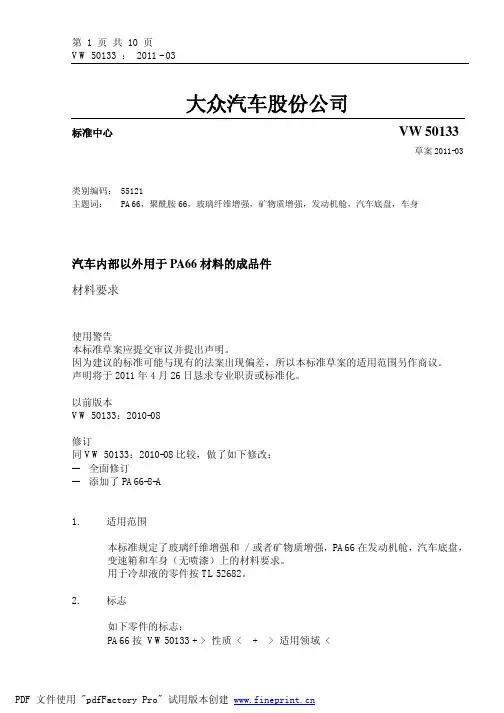
大众汽车股份公司标准中心VW 50133草案2011-03类别编码:55121主题词:PA66,聚酰胺66,玻璃纤维增强,矿物质增强,发动机舱,汽车底盘,车身汽车内部以外用于PA66材料的成品件材料要求使用警告本标准草案应提交审议并提出声明。
因为建议的标准可能与现有的法案出现偏差,所以本标准草案的适用范围另作商议。
声明将于2011年4月26日恳求专业职责或标准化。
以前版本VW 50133:2010-08修订同VW 50133:2010-08比较,做了如下修改:-- 全面修订-- 添加了PA66-8-A1.适用范围本标准规定了玻璃纤维增强和/ 或者矿物质增强,PA66在发动机舱,汽车底盘,变速箱和车身(无喷漆)上的材料要求。
用于冷却液的零件按TL 52682。
2.标志如下零件的标志:PA66按VW50133 + > 性质< + > 适用领域<如果表2至表6没有给出适用领域,只需陈述其性能例如:一个进气歧管插入件的材料是聚酰胺66,含30%的玻璃纤维:PA66按VW50133 - PA66-6-A –进气歧管3要求3.1 基本要求首次供货和更改的批准按VW 01155。
避免有害物质按VW 91101。
在从成品件上取得的样件上做试验。
为了全面彻底的检查,需要5个成品件。
如果不能在零件上面做试验,可以再数据页或者说在测试台上做试验。
3.2特性这些成品件的表面以及和功能相关的区域不得有诸如缩孔,裂纹,汇流接缝的缺陷和制造缺陷。
如果在与功能相关的区域上有缩孔或其它制造缺陷,那么供货商得有在所有负载条件下尺寸安全性的证明。
限定范围的样品与专业部门协调。
成品件必须可实现完美无缺的装配。
不允许功能性危险或安装人员被毛刺划伤的危险。
3.3制造注塑成型法3.4预处理干燥状态(预处理之前)和预处理后状态的区别。
样件在干燥状态:在试验之前直至恒重状态脱干(见7.2章节)并且在干燥的大气环境中存放不出现断裂的情况。
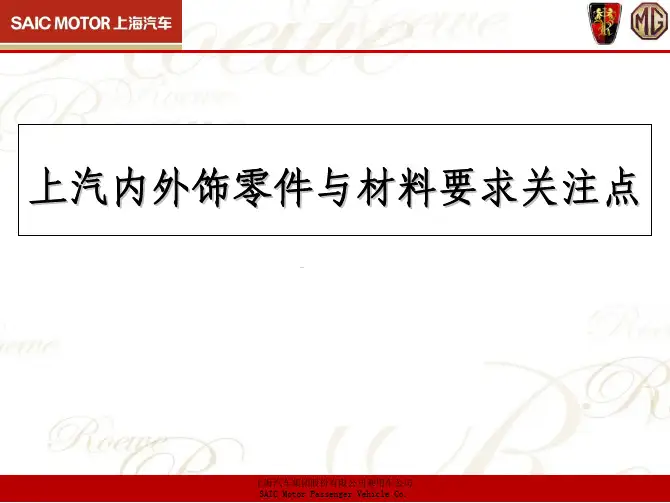
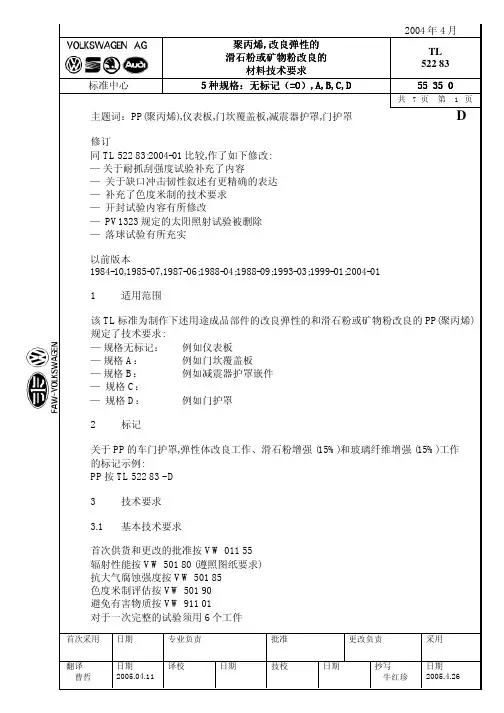
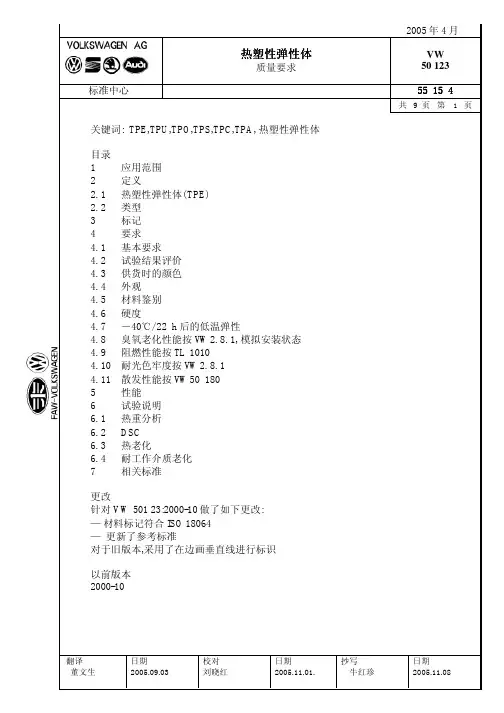
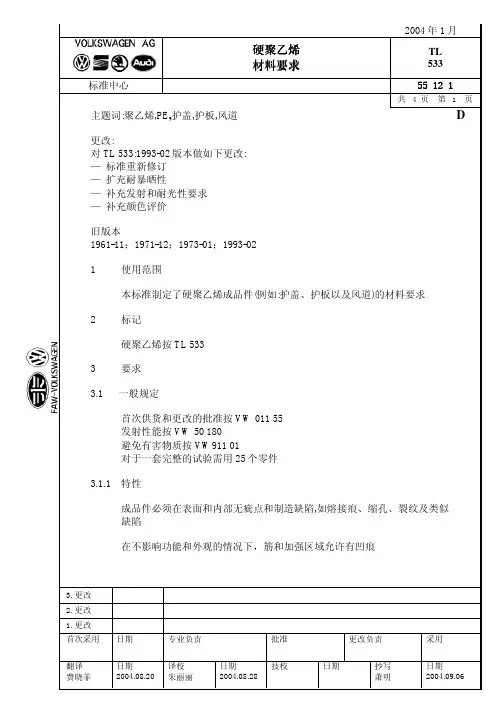
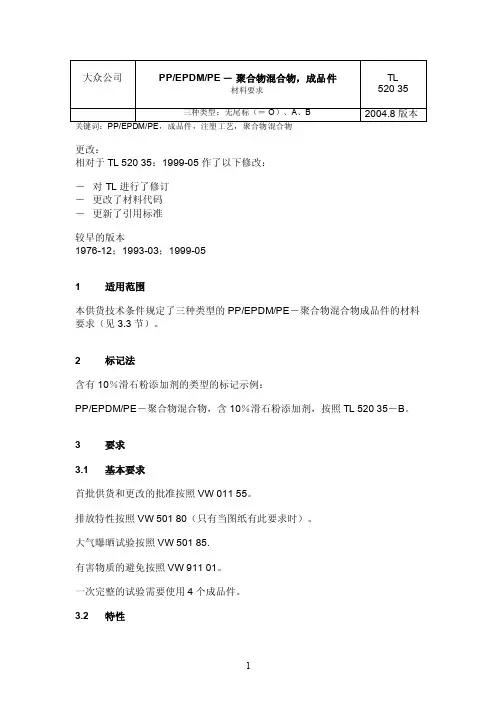
更改:相对于TL 520 35:1999-05作了以下修改:-对TL进行了修订-更改了材料代码-更新了引用标准较早的版本1976-12;1993-03;1999-051 适用范围本供货技术条件规定了三种类型的PP/EPDM/PE-聚合物混合物成品件的材料要求(见3.3节)。
2 标记法含有10%滑石粉添加剂的类型的标记示例:PP/EPDM/PE-聚合物混合物,含10%滑石粉添加剂,按照TL 520 35-B。
3 要求3.1 基本要求首批供货和更改的批准按照VW 011 55。
排放特性按照VW 501 80(只有当图纸有此要求时)。
大气曝晒试验按照VW 501 85.有害物质的避免按照VW 911 01。
一次完整的试验需要使用4个成品件。
3.2 特性成品件的表面和内部不得有诸如渗化线、缩孔、裂纹以及其它类似的缺陷部位和制造缺陷。
在筋和加强件凸出部位上允许有缩孔,但它不得影响零件的功能和外观。
3.3 类型-TL 520 35 PP/EPDM/PE-聚合物混合物,在+230C时弯曲强度≥18N/mm2。
-TL 520 35-A PP/EPDM/PE-聚合物混合物,在+230C时弯曲强度≥27N/mm2。
-TL 520 35-B PP/EPDM/PE-聚合物混合物,含10%滑石粉添加剂,或PP/EPDM-聚合物混合物,含10%滑石粉添加剂3.4 按照VDA 260的材料代码-TL 520 35和TL 520 35-A: >PP+EPDM+PE<-TL 520 35-B:>PP+EPDM+PE-TD10<或>PP+EPDM-TD10<3.5 制造工艺注塑工艺3.6 测量结果的评定所要求的数值适用于每次单独的测量。
3.7 试验日期成品件应至少在生产14天后才能用于试验。
3.8 材料见5.1节。
-TL 520 35和TL 520 35-A PP/EPDM/PE聚合物混合物,着色,耐热老化和紫外线照射-TL 52035-B PP/EPDM/PE聚合物混合物,可选PP/EPDM聚合物混合物,添加滑石粉,着色,耐热老化和紫外线照射3.9 色调按照图纸。
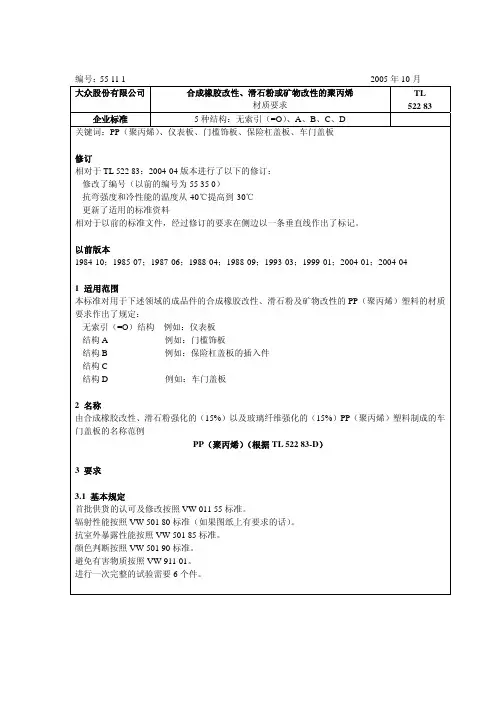
VW50133⼤众最新标准PA66Group standardVW 50133Issue 2015-08Class. No.:55121Descriptors:PA66, polyamide 66, polyamide, glass fiber-reinforced, mineral-reinforced, engine compartment,chassis, body, engine, transmissionPA66 for Finished Parts Outside the Vehicle Interior Requirements on MaterialsPrevious issuesVW 50133: 2010-08, 2011-05ChangesThe following changes have been made to VW 50133: 2011-05:–Standard completely revised –Applicable documents updated ContentsPageScope .........................................................................................................................2Designation ................................................................................................................2Requirements .............................................................................................................2Basic requirements ....................................................................................................2Appearance ................................................................................................................3Manufacture ...............................................................................................................3Conditioning ...............................................................................................................3Evaluation of the measurement results ......................................................................3Material requirements ................................................................................................3Workmanship .............................................................................................................3Moisture content .........................................................................................................4Melting temperature ...................................................................................................4Elevated-temperature behavior ..................................................................................4Low-temperature behavior .........................................................................................4General requirements on materials ............................................................................5Requirements dependent on the place of use ...........................................................7Notes on testing . (10)1233.13.23.33.43.544.14.24.34.44.5567Always use the latest version of this standard.This electronically generated standard is authentic and valid without signature.The English translation is believed to be accurate. In case of discrepancies, the German version is alone authoritative and controlling.Page 1 of 14All rights reserved. No part of this document may be provided to third parties or reproduced without the prior consent of one of the Volkswagen Group’s Standards departments.Volkswagen AktiengesellschaftVWNORM-2015-07dUpdated translation: December 2016Q U E L L E : N O L I SPage 2VW 50133: 2015-08Workmanship ...........................................................................................................10Moisture content .......................................................................................................11Melting temperature .................................................................................................11Elevated-temperature behavior ................................................................................11Low-temperature behavior .......................................................................................11Notched impact strength ..........................................................................................11Tensile test ...............................................................................................................11Aging in transmission fluid .......................................................................................11Heat aging ................................................................................................................12Aging in engine oil ....................................................................................................12Aging in grease ........................................................................................................12Flexural strength ......................................................................................................12Impact strength ........................................................................................................12Fan wheel weld line strength ....................................................................................12Applicable documents ..............................................................................................137.17.27.37.47.57.67.77.87.97.107.117.127.137.148ScopeThis standard defines the requirements on materials for non-reinforced, glass fiber-reinforced,and/or mineral-reinforced polyamide 66 (PA66) used in the engine, chassis, transmission, and body areas (without paint).For components that carry coolant, Technical Supply Specification TL 52682 applies.DesignationThe designation consists of the following parts:PA66 as per VW 50133 + >grade< + >area of application<If none of the areas of application listed in table 2 to table 7 apply, only the grade is specified.Example for a part made of polyamide 66 with 30% glass fiber for use in the air intake area:PA66-GF30 as per VW 50133 – PA66-6-A – intake manifoldRequirements Basic requirementsApproval of first supply and changes as per Volkswagen standard VW 01155Avoidance of hazardous substances as per VW 91101.The tests must be carried out on specimens made from finished parts. If the tests cannot be per‐formed on the component due to its geometry, reference may be given to data sheets or to meas‐urements performed on test plates.Characteristic values measured on finished parts can deviate from standard specifications. The de‐viations must be agreed upon with the appropriate Material Engineering department and, if neces‐sary, noted on the drawing.123 3.1Page 3VW 50133: 2015-08AppearanceThe finished parts must be free of flaws and processing defects (voids, cracks, cold shuts, etc.) on the surface.For parts that are subject to high loads or are especially functionally critical, an examination with regard to porosity and appearance as per VW 50093 must be performed. After positive test results,the measured characteristic values must be recorded on the drawing. The appropriate Design En‐gineering department decides, together with the Material Engineering department, on the necessity for porosity specifications.The parts must permit proper assembly. There must not be any functional risks and/or risks of in‐jury for assembly workers due to burrs and/or residual foreign matter becoming loose.ManufactureThe materials are intended for injection molding or blow molding processes.If the PA66 is not modified for impact resistance, using homogeneous regrind from the first machin‐ing process is permissible up to a content of 30 weight percent. Components must be validated with the maximum regrind percentage to be expected. The use of recycled materials, that is, raw materials made from outside processing sources, is permissible only after consultation with the ap‐propriate Design Engineering department and must be explicitly noted on the drawing.ConditioningA distinction is made between "dry " and "conditioned " conditioning states.Specimens from components in the "dry " state have been dried until their weight remains constant (see section 7.2) and continuously stored in a dry atmosphere before the testing. Specimens in the "conditioned " state are specimens in the "dry" state that are aged in a water-tight bag filled with water at 70 °C until the equilibrium state in table 1 is reached. Deviating from this procedure, specimens may also be conditioned as per DIN EN ISO 1110.Evaluation of the measurement resultsThe required numerical values apply to each individual measurement.Material requirementsSpecial requirements on materials (e.g., lightfastness, flammability, emissions) must also be ob‐tained from the drawing.WorkmanshipSee section 7.1.No through-thickness cracks or damage that could impair the function are permissible on the com‐ponent.3.2 3.33.43.544.1Page 4VW 50133: 2015-08Moisture contentSee section 7.2.It must be ensured that the parts are delivered to the plants that will be using them with a minimum moisture content of >0.7 weight percent H 2O.For parts that are clipped, latched, or installed with snap-on hooks during installation, the moisture content must correspond to the equilibrium state specified in table 1, see also section 3.2.Deviations must be noted on the drawing and are permissible only after discussion with the appro‐priate Design Engineering and Material Engineering departments.Melting temperatureSee section 7.3.The melting temperature must be >255 °C.Elevated-temperature behaviorSee section 7.4.The parts must not exhibit any change in shape or surface after heat aging; the dimensional change in length and width must not exceed 0.5%.Low-temperature behaviorSee section 7.5.The finished parts must be fully functional at low temperatures. They must remain free of cracks and other damage after being subsequently heated up to room temperature.4.2 4.34.44.5P a g e 5V W 50133: 2015-08G e n e r a l r e q u i r e m e n t s o n m a t e r i a l sT h e r e q u i r e d p r o p e r t i e s d e p e n d e n t o n t h e f i l l e r m u s t b e o b t a i n e d f r o m t a b l e 1. T a b l e 15P a g e 6V W 50133: 2015-08Page 7VW 50133: 2015-08 Requirements dependent on the place of use6For some places of use, additional requirements must be met; see table 2 to table 9.The use of inorganic heat stabilizers in the polymer for transmission parts in contact with oil (e.g., connectors, printed circuit boards, mechatronics) is prohibited. In this case, the fulfillment of the function must be ensured through the use of alternatives (e.g., organic stabilizers).Table 2 – TransmissionTable 3 – Engine oilPage 8VW 50133: 2015-08No.Property Unit Requirement%≤ 502.1.1for a filler content< 30 weight percent%≤ 302.1.2for a filler content≥ 30 weight percentTable 4 – IntakeTable 5 – Engine ventilationPage 9VW 50133: 2015-08No.Property Unit Requirement2.1Change (as a percentage) in mechanical properties in comparison to as-received condi‐tion (dry yield stress/fracture stress, dry elongation at break, dry notched impact strength) 2.1.1for a filler content < 30 weight percent %≤ 502.1.2for a filler content ≥ 30 weight percent%≤ 30Table 6 – GreaseTable 7 – Hot airFor application in the fan wheel area, PA66-GF30 is preferred. Different materials must be agreed upon with the appropriate Material Engineering department.Table 8 – Fan wheelPage 10VW 50133: 2015-08For application in the radiator fan mounting frame area, PA66-GF30 is preferred. Different materi‐als must be agreed upon with the appropriate Material Engineering department. Table 9 – Radiator fan mounting frameNotes on testing WorkmanshipAt least 3 whole finished parts must be stored in a medium that promotes environmental stress cracking (for better comparability, the use of coolant as per TL 774, "G12++" without added water is recommended). The storage period is 48 h at a bath temperature of (135 ± 1) °C. Large parts must be stored in an insulated container made from an inert material, such as stainless steel or glass (no plastic). Circulation must be provided for the bath so that any temperature differences within the whole setup are less than 2 K. Smaller parts may also be stored in suitable, covered containers (beakers with covers/watch-glass) in a circulating air oven. Here, the temperature of the medium must be monitored so that it reaches the desired temperatures.The test medium must be regularly monitored with regard to its effective properties and replaced if necessary. The devices under test (DUTs) must be heated to 135 °C together with the test fluid.After coolant aging, the DUTs must be rinsed with tap water and then dried for 24 h at 70 °C. They are then evaluated.7 7.1Page 11The moisture content is determined by drying the specimens in the (vacuum) oven. At least3 specimens must be taken from 3 parts; these specimens are weighed with an accuracy of 0.01 g and are then dried at 80 °C until a constant weight is obtained. Before the second weighing, the specimens must be cooled down to (23 ± 2) °C in a desiccator. The moisture content may also be determined with commercial moisture meters.Melting temperatureThe melting temperature must be determined by means of DSC (differential scanning calorimetry)as per DIN EN ISO 11357-1.Elevated-temperature behaviorHeat-aging test as per DIN 53497, method B, to be performed on at least one complete finished part.The aging time is (22 ± 2) h and the aging temperature is (150 ± 5) °C unless otherwise specified in the drawing or release.Low-temperature behaviorAt least 2 finished parts that have been conditioned in a standard climate must be aged at (?40 ± 1) °C for (22 ± 2) h.Notched impact strengthThe notched bar impact bending test (impact on narrow side) as per DIN EN ISO 179-1/1eA must be performed. If the standard specimen size cannot be prepared from the part, a specimen with length: (50 ± 1) mm, width: (10 ± 0.2) mm, thickness as in finished product (up to max. 4 mm);notch type: V-notch; support spacing (support width): 40 mm; test equipment: pendulum impact tester 4J may be used.Tensile testThe yield stress and the elongation at break must be determined with a tensile test as per DIN EN ISO 527-1 and DIN EN ISO 527-2, specimen 5A; test speed: 10 mm/min.Aging in transmission fluidBefore the aging in transmission fluid starts, the specimens (dry condition; at least 3 each for the subsequent tensile test and notched bar impact test) must be weighed with an accuracy of 0.01 g.These specimens must then be aged in the defined transmission fluid at 150 °C for 96 h.A second set of specimens must be aged in the corresponding transmission fluid for 504 h at150 °C. The specimens must be stored in closed (non airtight) containers (e.g., watch-glass or alu‐minum foil pressed over the edges). The specimens must be stored at least 3 cm above the bottom of the container.After being removed from the fluid, the specimens must be dried with a cloth, weighed again, and then subjected to the mechanical tests. If the mechanical characteristic values are already outside of the requirements after 96 h, the 504 h aging test must be stopped.7.2 7.37.47.57.67.77.8Page 12VW 50133: 2015-08Heat agingFor heat aging, at least 1 complete finished part and specimens (at least 3 each for each subse‐quent mechanical test) must be aged in a forced-air oven at 150 °C for 1 000 h as per DIN 53497.After aging, the specimens must be stored in a desiccator unless they are subjected to the me‐chanical tests immediately after aging.Aging in engine oilAt least 3 specimens (dry conditioning) for each subsequent mechanical test must be aged at 150 °C for at least 1 000 h in a test oil as per TL 52185 or as per the drawing specification. After completion of the aging period, the specimens are wiped dry and checked with regard to changes in their mechanical properties.Aging in greaseAt least 3 specimens (dry conditioning) for each subsequent mechanical test must be aged at 70 °C for at least 1 000 h in a grease as per TL 745 and TL 735 or as per the drawing specifica‐tion. After completion of the aging period, the specimens are wiped dry and checked with regard to changes in their mechanical properties.Flexural strengthThe flexural stress is determined at maximum load as per DIN EN ISO 178.Specimen with length: (50 ± 1) mm; width: (10 ± 0.2) mm; thickness as in the finished product (up to a max. of 4 mm); support spacing: 40 mm; radius of support: 1.0 mm to 1.2 mm; test speed:(14 ± 1) mm/min.Specimens taken from molded parts with one-sided graining must be placed on the test machine supports so that the grained side faces the loading edge.Impact strengthImpact strength test (impact on wide side) as per DIN EN ISO 179-1.Specimen length: (50 ± 1) mm, width: (6 ± 0.2) mm, thickness as in the finished product (up to a max. of 4 mm); distance between supports (support spacing): 40 mm; test equipment: pendulum impact tester 4J.Specimens taken from finished parts with one-sided graining must be positioned on the supports of the pendulum impact tester with the grained side facing the hammer edge.The specimens must be tested in a "dry" conditioning state.Fan wheel weld line strengthThe flexural stress is determined at maximum load as per DIN EN ISO 178.Specimen with length: (60 ± 1) mm; width: (10 ± 0.2) mm; thickness as in the finished product (up to a max. of 4 mm); support spacing: 40 mm; radius of support: 1.0 mm to 1.2 mm; test speed:(14 ± 1) mm/min.The weld line of the outer fan ring is in the middle of the specimen.The curvature of the specimen points upward and the weld line is at the point where the force is applied.7.9 7.107.117.127.137.14Page 13Figure 1 – Orientation of the flexural specimens; the dashed line marks the meeting zone.(Schematic photo; not necessarily of the part to be tested.)Applicable documentsThe following documents cited in this standard are necessary to its application.Some of the cited documents are translations from the German original. The translations of Ger‐man terms in such documents may differ from those used in this standard, resulting in terminologi‐cal inconsistency.Standards whose titles are given in German may be available only in German. Editions in other languages may be available from the institution issuing the standard.PV3936Polymer Materials; Testing the Resistance to Constituents of Blowby GasesTL 52145Synthetic Transmission Oil API GL 5 SAE 75W-90/SAE 75W-85; Lubri‐cant RequirementsTL 52185Reference Engine Oil SAE 5W-30 for Testing of Compatibility with Re‐spect to Elastomer Materials; Lubricant RequirementsTL 52682PA66, Glass Fiber-Reinforced, for Finished Parts Carrying Coolant; Ma‐terial RequirementsTL 735Multi-Purpose Grease; Lubricant RequirementsTL 745Multi-Purpose Low-Temperature Grease; Lubricant Requirements TL 774Ethylene-Glycol-Based Coolant Additive; Materials Requirements VW 01155Vehicle Parts; Approval of First Supply and Changes VW 50093Porosity of Castings; RequirementsVW 50554Standard Atmospheres and Room Temperatures; Requirements on Standard AtmospheresVW 91101Environmental Standard for Vehicles; Vehicle Parts, Materials, Operat‐ing Fluids; Avoidance of Hazardous Substances8Page 14VW 50133: 2015-08DIN 53497Testing of Plastics; Hot Storage Test on Mouldings Made of Thermo‐plastic Moulding Materials without External Mechanical StressingDIN EN ISO 1110Plastics - Polyamides - Accelerated conditioning of test specimensDIN EN ISO 11357-1Plastics - Differential scanning calorimetry (DSC) - Part 1: General prin‐ciplesDIN EN ISO 1172Textile-glass-reinforced plastics - Prepregs, moulding compounds andlaminates - Determination of the textile-glass and mineral-filler content;calcination methodsDIN EN ISO 1183-1Plastics - Methods for determining the density of non-cellular plastics -Part 1: Immersion method, liquid pyknometer method and titration meth‐odDIN EN ISO 178Plastics - Determination of flexural propertiesDIN EN ISO 179-1Plastics - Determination of Charpy impact properties - Part 1: Non-instru‐mented impact testDIN EN ISO 527-1Plastics - Determination of tensile properties - Part 1: General principles DIN EN ISO 527-2Plastics - Determination of tensile properties - Part 2: Test conditions formoulding and extrusion plasticsVDA 260Components of motor vehicles - Marking of material。
【干货】大众汽车16项零部件检测标准汽车供应链对质量越来越关注,伴随着众多零部件和原材料在很多不同的地区和供应商采购,期望着每一个质量环节都能达到高的质量标准,同时也期望在开始就知道这些质量信息,并期望着众多的供应商能在现在和未来都能持续满足他们的需要,这是一个挑战,同时也是一个机遇以证明产品质量并且与汽车供应链建立持续的互动联系。
检测技术服务有限公司向各大汽车零部件供应商提供贯穿整个汽车及其零部件从生产到价值链的服务,帮客户降低风险,抵抗质量危机。
大众集团作为汽车行业的领导者,对汽车零部件的检测可谓是丝毫不漏,下面我们看看16项零部件检测项目都有哪些。
图片来源:上海金玺1.汽车用材料测试:1)高分子材料测试(机械力学性能、热学性能、绝缘电性能、耐化学药品测试、人工加速老化、燃烧测试等);2)反光测试测试(尺寸、颜色、反光性能、耐着力、冲击性能、冲击强度、抗磨性能、色牢度、盐雾试验、压缩性能、绕曲强度、裂纹等);3)泡沫泡棉材料测试(表观密度、压缩形变、硬度、拉伸性能、吸水率、导热系数、反抗弹力、燃烧性能等);4)橡胶材料测试(密度、硬度、拉伸性能、冲击性能、挠曲性能、门尼粘度、热学性能、燃烧试验、人工加速老化试验、耐化学试剂、耐油试验等)。
2.汽车外饰件测试:1)适用产品:汽车前后塑料(金属)保险杠、金属&非金属翼子板、后视镜壳、发动机罩、外装饰件、防撞条等。
2)测试项目:机械力学性能、刚强度、变形量测试、表层厚度测试、附着力测试、抗腐蚀测试、抗磨耗测试、高低温环境测试/紫外线老化测试、紫外/氙弧光老化、高低温环境力学试验、环境机械性能测试、沙尘/淋雨/飞石测试、金相测试、无损探伤、综合性能测试/疲劳耐久测试等。
3.汽车内饰件测试:1)适用产品:方向盘、汽车门内饰件总成、玻璃升降开关、汽车顶棚、遮阳板、车内扶手、立柱饰板、行李箱、各种开关、汽车座椅、汽车地毯等。
2)测试项目:材料重金属成分分析、挥发性有机化合物分析、车内其他受限制成分分析、内饰件材料阻燃成分分析、燃烧性能测试、燃烧烟雾尘粒测试、高低温/湿热测试、高低温冲击测试、温度/湿度/盐度多循环耐腐蚀测试、人工加速紫外光/氙弧光/自然光老化测试、各种环境下的机械冲击、机械拉压、变形量等力学测试、粉尘环境测试、霉斑环境测试、部件的装配、皮革/纺织品性能测试、雾化测试等。
大众汽车标准_TL52476德文-POM材料规范Q U E L L E : N O L I SSeite 2TL 524 76: 2003-01D3.1.2 Humanvertr?glichkeitDie verwendeten Materialien müssen physiologisch unbedenklich sein. Bezüglich der bei h?heren Temperaturen ausdünstenden Substanzen muss toxikologische Unbedenklichkeit bestehen.3.1.3 VerpackungDie Fertigteile müssen luftdurchl?ssig verpackt sein und bei Anlieferung in gr??eren Verpackungs-einheiten (Kartonagen, Paletten) dort auch so gestapelt oder angeordnet sein, dass eine Luftzirku-lation m?glich ist.3.2 HerstellungSpritzgie?verfahren3.3 Ausführungen─TL 524 76, Ausführung ohne Index:POM-Standard-Spritzgusstyp für z. B. Lautsprecherabdeckungen, Kraftstoff-F?rdereinheiten und Verbindungselemente (Clips).─TL 524 76, Ausführung A:POM, gegen den Einfluss saurer Medien additiviert, für z. B. Kraftstoff-F?rdereinheiten von Dieselfahrzeugen mit erh?hter Anforderung an die Best?ndigkeit gegenüber Dieselkraftstoff-Abbauprodukten.3.4 Kennzeichnung nach VDA 260Beide Ausführungen: >POM<3.5 KonditionierungDie für die einzelnen Prüfungen erforderlichen Proben sind vor den Prüfungen mindestens 48 h im Normalklima DIN 50 014 - 23/50-2 zu konditionieren.3.6 Gültigkeit der AnforderungenDie geforderten Zahlenwerte gelten für jede Einzelmessung.3.7 WerkstoffSiehe Abschnitt 5.1.─Ausführung ohne Index:Polyoxymethylen (POM)-Homo- wahlweise Copolymerisat.─Ausführung A:Polyoxymethylen (POM)-Copolymerisat, gegen den Einfluss saurer Medien additiviert.3.8 Farbton─Ausführung ohne Index:Nach Zeichnung.─Ausführung A:Zur besseren Unterscheidung zur Ausführung ohne Index vorzugsweise orangefarben pigmen-tiert.Seite 3TL 524 76: 2003-01D 4 EigenschaftenSiehe Tabelle 1.Tabelle 1Seite 4TL 524 76: 2003-01D5 Prüfungshinweise5.1 WerkstoffDie Identit?tsprüfung erfolgt infrarotspektroskopisch.5.2 SchmelztemperaturWird zur Bestimmung der Schmelztemperatur die DSC-Methode gew?hlt, ist wie folgt zu verfahren: Als Prüfger?t kann z.B. das DSC7 der Firma Perking Elmer verwendet werden. Als Probe dient ein planparalleler Fertigteilabschnitt mit einer Masse von ca. 10 mg.Prüfparameter: Die Probe wird von 50 °C auf 180 °C mit einer Aufheizrate von 10 °C/min aufge-heizt. Die Untersuchung findet unter Raumatmosph?re statt.5.3 Kugeldruckh?rteDie Messungen sind an mindestens drei (20 x 20) mm gro?en Probek?rpern auszuführen (2 Mes-sungen je Probe). Bei Proben, die aus einseitig genarbten Fertigteilen herausgearbeitet wurden, ist mit Hilfe eines Planschleifger?tes die Narbung zu entfernen. Die so geschaffene plane Fl?che dient als Auflagefl?che. Die Messung erfolgt auf der unbearbeiteten Rückseite. Messzeit 10 s.5.4 Streckspannung und StreckdehnungZugversuch nach DIN EN ISO 527-2, Probek?rper 5A, Prüfgeschwindigkeit 50 mm/min. Ist die Entnahme des Probek?rpers 5A nicht m?glich, ist die Verwendung von S3A-Zugproben (Schulter-stab) nach DIN 53 504 zul?ssig.5.5 Schlagz?higkeitSchlagbiegeversuch (breitseitiger Schlag) gem?? DIN EN ISO 179-1, jedoch Probek?rper L?nge: (50 ± 1) mm, Breite: (6 ± 0,2) mm, Dicke entsprechend der Erzeugnisdicke (bis max. 4 mm); Wider-lagerabstand (Stützweite): 40 mm, Prüfger?t Pendelschlagwerk 4J.Aus einseitig genarbten oder lackierten Fertigteilen hergestellte Proben sind so auf die Widerlager des Pendelschlagwerkes zu legen, dass die genarbte oder lackierteSeite gegen die Hammer-schneide zeigt.5.6 Kerbschlagz?higkeitSchlagbiegeversuch (breitseitiger Schlag) gem?? DIN EN ISO 179-1, jedoch Probek?rper L?nge: (50 ± 1) mm, Breite: (6 ± 0,2) mm, Dicke entsprechend der Erzeugnisdicke (bis max. 4 mm); Wider-lagerabstand (Stützweite): 40 mm, Prüfger?t Pendelschlagwerk 4J.Die Proben werden breitseitig mit einer 0,8 mm breiten U-f?rmigen Kerbe versehen. Die Kerbtiefe betr?gt 1/3 der Probendicke. Die den Kerbgrund begrenzenden Kanten müssen einen Rundungs-halbmesser von < 0,1 mm aufweisen.Aus einseitig genarbten Fertigteilen hergestellte Proben werden auf der genarbten Seite gekerbt. 5.7 W?rmeverhalten Warmlagerungsversuch nach DIN 53 497, Verfahren B, an mindestens einem kompletten Fertigteil; Lagerungstemperatur (90 ± 1) °C; Lagerungsdauer (22 + 2) h.Seite 5TL 524 76: 2003-01D 5.8 K?lteverhaltenLagerung von mindestens zwei kompletten Fertigteilen in Luft bei (-40 ±1) °C; La gerungsdauer (22 + 2) h.Kugelfallprüfung5.9 K?lteverhalten,Kugelfallprüfung nach PV 3905, jedoch Grundplatte (Probenauflagefl?che) aus ≥ 10 mm dickem Stahlblech ohne Vertiefung an mindestens drei Fertigteilen. Kugelfallh?he (450 ± 5) mm.5.10 LichtechtheitFalls in der Zeichnung die Anzahl von Belichtungsperioden nicht definiert ist, gilt folgende Rege-lung:─ 3 Belichtungsperioden für Bauteile im Bereich indirekter Sonneneinstrahlung.─ 5 Belichtungsperioden für Bauteile im Bereich direkter Sonneneinstrahlung (z. B. Türbrüstung). ─10 Belichtungsperioden für Bauteile im Bereich h?chster Sonneneinstrahlung (z. B. Heckabla-ge).Unterlagen6 MitgeltendeTL 1010 Innenausstattungsmaterialien, Brennverhalten; WerkstoffanforderungenPV 1303 Nichtmeta llische Werkstoffe; Belichtungsprüfung für Bauteile des Fahrzeu-ginnenraumesPV 3905 Organische Werkstoffe; KugelfallprüfungVW 011 55 Fahrzeug-Zulieferteile allgemein; Genehmigung von Erstlieferung und ?n-derungVW 501 80 Bauteile des Fahrzeuginnenraumes; EmissionsverhaltenVW 501 85 Fahrzeugbauteile; Freibewitterungsbest?ndigkeit VW 911 01 Umweltnorm Fahrzeug, Fahrzeugteile, Werkstoffe, Betriebsstoffe; Schad-stoffvermeidungDIN 50 014 Klimate und ihre technische Anwendung; NormalklimateDIN 53 479 Prüfung von Kunststoffen und Elastomeren; Bestimmung der DichteDIN 53 497 Prüfung von Kunststoffen; Warmlagerungsversuch an Formteilen aus ther-moplastischen Formmassen ohne ?u?ere mechanische Beanspruchung DIN 53 504 Prüfung von Kautschuk und Elastomeren; Besti mmung von Rei?festigkeit, Zugfestigkeit, Rei?dehnung und Spannungswerten im ZugversuchDIN EN ISO 179-1 Kunststoffe; Bestimmung der Charpy-Schlagz?higkeit; Teil 1: Nicht instru-mentierte Schlagz?higkeitsprüfungDIN EN ISO 527-2 Kunststoffe; Bestimmung der Zugeigenschaften; Prüfbedingungen für Form- und Extrusionsmassen.DIN EN ISO 2039-1 Kunststoffe; Bestimmung der H?rte, Teil 1: KugeleindruckversuchDIN EN ISO 3146 Kunststoffe; Bestimmung des Schmelzverhaltens (Schmelztemperatur oder Schmelzbereich) von teilkristallinen PolymerenDIN EN 20 105-A02 Textilien; Farbechtheitsprüfungen, Teil A02: Grauma?stab zur Bewertung der ?nderung der Farbe VDA 260 Bauteile von Kraftfahrzeugen, Kennzeichnung der Werkstoffe。